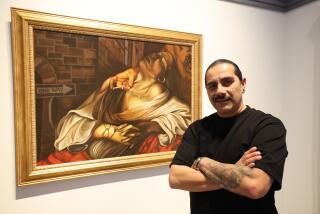Amalia Pica’s protest art screams its message with whispers of white
Amalia Pica’s exhibition at Marc Foxx pays tribute to the Provos, a counterculture movement in 1960s Amsterdam that used nonviolent happenings to provoke violence from police, whom the movement saw as unwitting “co-happeners.”
Although the Provos had concrete goals — combating air pollution, providing free sex education and child care — the protests were often, well, provocative. In one instance participants handed out blank white fliers. They were also known for painting things white, such as the free bicycles they provided in the city, or the chimneys of air polluters.
Pica pays homage to these actions by papering one wall of the gallery with standard-size sheets of blank white paper. The white-on-white work is barely perceptible but notable for its quietude. It whispers instead of shouts, suggesting that sometimes merely asserting one’s presence can be an act of protest.
By contrast, the adjacent wall is hung with all manner of noisemaking tools — drums, plastic jugs, pots and pans, bullhorns — as well as more sinister things like sticks and machetes. These have all been coated in white plaster. In some ways it’s a silencing of the objects; they look like ghosts. But in their homage to the Provos’ penchant for white, it is conversely also a way of making them heard.
Pica underscores this point with four giant sculptures of hearing aids, arrayed across the floor. They are a cheeky suggestion to the “giants” in power that they need some help with listening. There is also an array of white protest signs across which Pica has painted a colorful bunting, a gesture of unity.
A seemingly unrelated suite of drawings is displayed in a side room. Made using only standard rubber stamps — the ones that say “Paid” or the date, for example — they transform routine efficiency into delightful reveries.
In these transformations Pica evokes not only the power of art — taking something intended for one purpose and using it for another — but also the power of protest: to envision the world otherwise and to try to make it so.
Marc Foxx, 6150 Wilshire Blvd., Los Angeles. Through Saturday. (323) 857-5571, www.marcfoxx.com
SIGN UP for the free Essential Arts & Culture newsletter »
Follow The Times’ arts team @culturemonster.
ALSO
Thrilling new exhibition shows modern Mexican art is bigger than murals
John M. Miller, artist behind painstakingly painted geometric abstractions, dies at 77
Roundup: The art of protest, Dakota Access edition
More to Read
The biggest entertainment stories
Get our big stories about Hollywood, film, television, music, arts, culture and more right in your inbox as soon as they publish.
You may occasionally receive promotional content from the Los Angeles Times.






